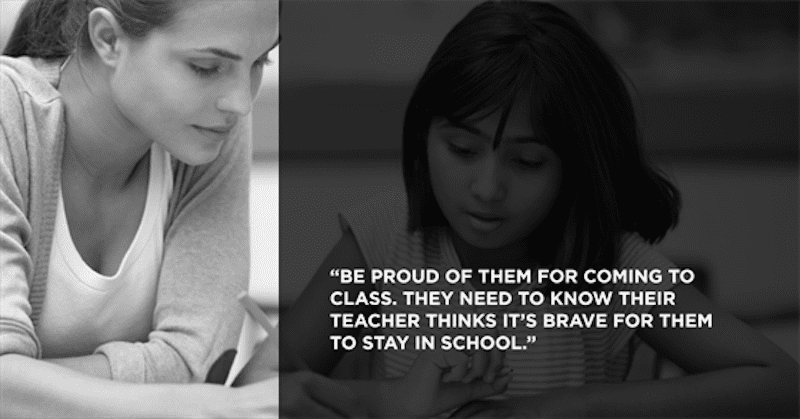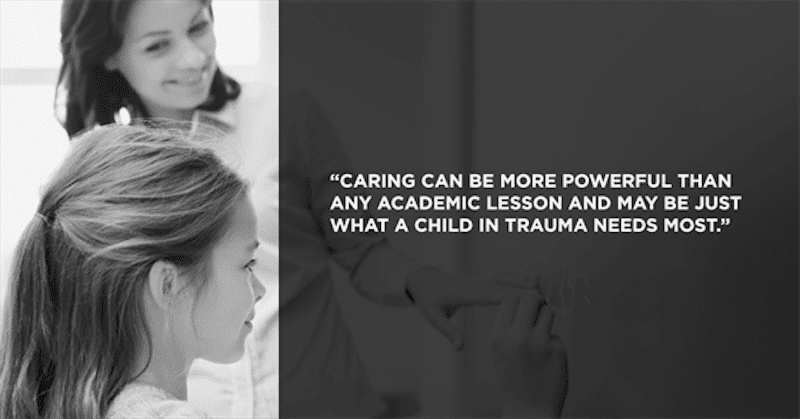When kids in our classrooms are hurting from traumatic experiences like divorce, bullying, and abuse, we want to help—but it can be hard to know just what to say or do. We collected real questions from teachers in our Facebook community about these tough situations and asked trauma expert Dr. Caelan Soma, chief clinical officer and senior trainer at Starr Commonwealth, a nonprofit organization that provides schools with resources to help children experiencing trauma, to share her best advice.
Q: “How can I help my first grade student whose family is going through a really difficult divorce? I am seeing regression in my student and a lot of anxiety around pickup and drop-off, and I want to approach her parents in a useful and non-confrontational way.”
A: Divorce is tough on students when they’re at home and at school, and your student is lucky to have a teacher who recognizes that and wants to help. Let the parents know you are noticing changes. Don’t bring up the divorce. Focus on the child and what you are seeing in class. If they tell you about the divorce, you are in the know, but don’t speculate. This will make the parent feel defensive and view you as placing blame rather than trying to help. Instead, ask them what behavior they’re seeing at home. Ask if there is anything you can do. The child will benefit most from consistency and routine in the classroom. Try to give your student ways to calm down on a sensory level—like breathing or stretching—to work through anxiety she may be feeling from home. While it may be frustrating that you can’t control what happens when your student leaves your classroom, you can feel good about the fact that the strategies you teach your student to use at school can translate to help her deal with the stress she experiences at home too.
Q: “How can I support my sixth grader whose grandmother just died? They were very close, and he just can’t seem to focus in class and is so withdrawn that I’m worried about him. How should I react? At what point do I contact a counselor or call a parent?”
A: Teachers are such caring individuals, and it’s so hard when they have constant worries about one of their students. While it may look like an oppositional behavior, your student may just need time to heal and to know you understand. You can normalize the reaction by telling your student, “I get it. It’s hard to pay attention. It’s going to come out of nowhere and you’re going to feel sad.” Give your student the OK to tell you if he needs to get a drink or put his head down during the day. Let his parents know about the changes and tell them you will keep in touch to update them on how things are improving or not. A school counselor may be helpful, but you don’t need to move to an intervention until the normal grief response period of six to eight weeks has passed. Generally, with emotional support at home and at school, a grieving child’s heart will heal significantly during that time period.
Q: “How can I help a second grader in my class who comes in from recess most days on the verge of tears because of bullying on the playground? I’ve not seen it in my classroom, and he hasn’t confided in me.”
A: Thank you for keeping your eyes and ears open to potential bullying in your school. It’s best to address the problem head-on. Ask the student and others, such as the recess monitor, what is happening. Link the student with a peer buddy and an adult he feels safe going to or giving a signal to when he is not having a good day. The code can be a wink or a silly word to alert someone he needs support. Bullying doesn’t have to be violent. It can be a look or a whisper. While it might not seem traumatic to adults, peers are the center of kids’ lives, and if they aren’t accepting of them, that’s traumatic. Intervene before the situation spirals into something that’s out of control, and you’ll be able to help your student on the road to happier days at school.

Q: “We had a 14-year-old girl in our school commit suicide, and everyone is in shock. How can I help my students get through this? This is the second suicide of a young girl this year.”
A: It can be very upsetting for both teachers and students when a student commits suicide. There is a lot of concern that talking about suicide and how it happened will lead to “contagion”—making other kids do it—but there is no research to back up that worry. For many kids, it’s the opposite, and for them, it’s better to talk about the situation. But remember, reactions vary. The event will be very upsetting to some of your students and not to others. We have to respect all symptoms and reactions. There is a continuum and everyone is going to be on a different page. Schools can offer an outlet for kids who are having the hardest time to come together to process the event, but no one should be required to talk about it. Make it optional. It’s best, too, that memorials—for any death—take place outside of school for the same reason. Students should have the choice to participate. It has nothing to do with disrespecting the family or not caring, but it has everything to do with respecting everybody else. When you respect and honor each student’s individual reactions, you help create a supportive environment that allows everyone to process and heal in his or her own way.
Q: “I have a fifth grader who has been placed in three different foster homes in the past year. What can I do to help him stay on track? His home life is so unstable, and I can see it’s affecting him at school too.”
A: It’s really hard for a teacher to see a student bounced around from foster home to foster home. The best thing you can do is to be the constant, stable person in your student’s world—and sometimes that’s enough. You don’t have control of what goes on outside your classroom. To have one consistent, caring adult in the life of a child—even if it’s not a caregiver or a parent—is one of the most beneficial characteristics of building resilience.

Q: “I’m having trouble connecting with one of my third graders whose family is homeless and lacks support at home. What can I do? Her mother is so overwhelmed that she basically told me she didn’t have energy to help her daughter or care how she is doing in school. I want to engage and motivate my student, but the mom’s attitude is rubbing off on my student.”
A: When parents aren’t emotionally available to support the positive things happening in the classroom, it can be really frustrating for teachers. It usually helps to shift the lens away from what you think is wrong with the mom to look at what’s happening in her world. The mom is in crisis and survival mode. Likely, she does care, but her priority is finding a place to live. Find a time to talk to her informally and briefly—no need for a big meeting, which could make her feel uncomfortable and defensive. Reframe the experience, rather than putting the blame on the mom. Tell her you know it’s a tough time and validate her feelings. Say to her, “I know you care. You just have so much going on now, but your daughter needs you to tell her you care and school is important.” Then ask how you can help. Separately, tell your student that you understand her mom is working hard, and it might not seem like she cares, but she really does—and so do you. Ask her how you can help. You may need to modify homework expectations or set up a peer support person to help her with assignments. The support and understanding you give to the parent and the student will help everyone connect and motivate your student to succeed.
Q: “I’m in my second year teaching middle school, and both years I’ve had a student in my class find out she’s pregnant. How can I support these girls? What do they need to hear from me? It’s such a sensitive situation.”
A: Teen pregnancy can be an overwhelming experience for these girls, but having a teacher like you who cares about their education can be invaluable. Treat the girls who are pregnant like the rest of the girls in the class. Do acknowledge that they are pregnant, but don’t make a big deal about it. Be proud of them for coming to class. When they know their teacher thinks it’s brave for them to stay in school, they’ll be more likely to keep coming to class.

Q: “How do I make school a safe place when I teach in one of the most dangerous cities in the country? It seems like there’s not a week that goes by when the students aren’t telling me about a stabbing or drive-by shooting. How do I help my students cope with ongoing news of student deaths as the result of violence and gang activity? What can I do to create a safe environment for them at school?”
A: It’s so tough for caring teachers to know they can’t control what’s happening to their students outside the classroom. The best thing you can do is be consistent inside your classroom. Have routines and try to connect with students. You may hear students say, “What’s the point?” Engage them in activities that allow them to feel some sense of hope—even if it’s just talking about activities in the near future that they are looking forward to doing. Allow for movement and physical-activity breaks in the classroom, so they can have some fun. Encourage them to seek out safe places, and become an advocate for after-school programs, clubs, and equipment in the parks. Your encouragement and effort will go a long way in helping them stay away from situations that may put them in harm’s way.
Q: “How can I support a high school student whose mother has terminal cancer and is in hospice care? What is the right thing to say to him? How can I accommodate him?”
A: Your student is lucky to have a compassionate teacher who wants to say the right thing. You can let the student know you understand his mom is sick and you are available to talk. Ask if there is someone to support him at home. Sometimes all the focus shifts to the sick person, but others in the family suffer and there is some unintentional neglect. Pay attention to changes in academics or behavior and make an accommodation if needed. Your caring support will be a bright light for this student during a very difficult and sad time in his life.
Q: “A 10th grade girl in my class was physically abused by her dad. How do I balance her need for support with the comfort level of her classmates? She’s been sharing a lot of details with other kids in class, and I can see it’s making them feel uncomfortable. I want to support her, but I also want to help her understand when it is appropriate to share.”
A: This type of situation can leave teachers feeling torn: You want to help the student who is suffering, but you also want to make sure the other students are comfortable in your classroom. It’s best to be direct. You want to protect the girl who was abused, but you also need to protect the other kids. Take her aside discretely and let her know it’s appropriate to share with a very close friend who desires to listen, a teacher or counselor, but it is not appropriate to share with everyone. When other students hear the details, they may perceive it can possibly happen to them, which can cause post-traumatic stress reactions in those students too. It doesn’t have to actually happen to them for it to worry them. If other kids are complaining, let them know they can come to you if she shares too much with them. They have a right not to be exposed to the discussion. Even though this may feel like a difficult conversation to have with a student, it will help her—as well as the rest of your class—feel safe and supported.
Q: “I have a second grader who was sexually abused by her uncle, and I fear for her safety. What should I do? She tells me her family still sees him—even at their house, and I’m worried about the situation.”
A: Thank you for being concerned and asking this important question. You should contact a school social worker and the principal. If you know this information, you are a mandated reporter. If the child is at risk of harm, you need to report it to be investigated. That’s a serious situation, and you can help your student greatly if you get the appropriate people involved as soon as possible.
Q: “How do I handle one of my special ed students in ninth grade with behavioral difficulties who had a close friend who was murdered? He’s sharing some pretty intense emotions in class, and I can’t imagine how difficult it must be for him to process.”
A: Especially when teachers are working with special education students, it can be hard to know when to draw the line. The classroom isn’t the best place for the student to share the details of what happened. Sometimes we see acting-out behavior as that becomes the only way the student is able to communicate their anger and frustration. But if the child is risking his safety or the safety of others, he should not be in the classroom. If it’s to that level, it’s escalated and it’s too much. In that case, the student definitely needs to be linked with a professional and removed from the classroom if safety is an issue. To best help this child, you should follow your school’s protocol for handling the behavior.
Q: “What should I do to work through my fourth graders’ grief over a student in our school who was killed in a car accident recently? Many of my students have never known anyone who died—let alone someone their own age.”
A: When tragedy strikes a community, it can affect the children in your classroom, and it can be tough on teachers too. People are often really curious to know the details. By giving the facts, you can reduce the rumor mill. It’s important for some brief notification to go out from the superintendent or principal that tells the community what happened—only to the point the family approves. Some kids will have more questions than others, and it’s best to answer to their level of curiosity. These events can sometimes make people feel helpless, and they want to do something to respond. Ask students if they’d like to make cards for the family to send their condolences, which is a compassionate way to support the family and help your students positively express their emotions.
Q: “Our community just experienced a tornado. How can I help my students get through this rough time and feel secure again? Many of my students are struggling in temporary housing. Others are scared whenever the sky looks threatening.”
A: When an event such as a natural disaster occurs and is so widespread that it affects the entire community, sometimes there can be a long period of transition where people are out of sorts. Acknowledge to your class that things are not like they were and it may be rocky. As people rebuild or another storm comes, memories can resurface along with feelings of stress. Natural disasters are so difficult because they affect so many people and they are unknown. It can lead to a chronic state of stress that may last up to a year as the family resettles, but your constant caring and support will make this time a lot easier on your students.
Bottom-Line Message
As teachers, we want to do whatever we can to help our students who are suffering. “Many times, however, the situations your students experience are so complicated, the best thing you can do is be there to listen,” says Soma. She adds, “Caring can be more powerful than any academic lesson and may be just what a child in trauma needs most.”



